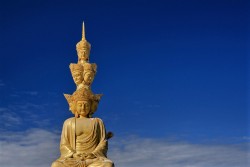

Introducing Mount Emei (from wikipedia)
Mount Emei is one of the Four Sacred Buddhist Mountains of China. Mt. Emei sits at the western rim of the Sichuan Basin. Mount Emei is traditionally regarded as the bodhimaṇḍa, or place of enlightenment, of the bodhisattva Samantabhadra. At 3,099 metres (10,167 ft), Mt. Emei is the highest of the Four Sacred Buddhist Mountains of China. Mount Emei is the location of the first Buddhist temple built in China in the 1st century CE. The site has seventy-six Buddhist monasteries of the Ming and Qing dynasties, most of them located near the mountain top. The monasteries demonstrate a flexible architectural style that adapts to the landscape. Some, such as the halls of Baoguosi, are built on terraces of varying levels, while others, including the structures of Leiyinsi, are on raised stilts. Here the fixed plans of Buddhist monasteries of earlier periods were modified or ignored in order to make full use of the natural scenery. Mount Emei was made a UNESCO World Heritage Site in 1996.
Mount Emei Fast Facts
• Chinese Name: E Mei Shan 峨眉山
• Best Time to Visit: April to October
• Recommended Visiting Time: About 1 to 2 days
• Things to Do: Photography, Hiking, Buddhism
• Opening Hours: 06:00-18:00 from Jan 16 to Dec 14; 07:00-18:00 from Dec 15 to Jan 15
• Entrance Fee: CNY160 from Jan 16 to Dec 14, CNY 110 from Dec 15 to Jan 15
• Address: Huangwan County, Emei, Leshan, Sichuan Province
UNESCO says of Mount Emei
Mount Emei is an area of exceptional cultural significance as it is the place where Buddhism first became established on Chinese territory and from where it spread widely through the East. The first Buddhist temple in China was built on the summit of Mount Emei in the 1st century CE. It became the Guangxiang Temple, receiving its present royal name of Huazang in 1614. The addition of more than 30 other temples including the Wannian Temple founded in the 4th century containing the 7.85m high Puxian (bodhisattva Samantabhadra) bronze Buddha of the 10th century, and garden temples including the Qingyin Pavilion complex of pavilions, towers and platforms dating from the early 6th century; the early 17th century Baoguo Temple and the Ligou Garden (Fuhu Temple) turned the mountain into one of Buddhism's holiest sites. Mount Emei is an area of striking scenic beauty. It is also of great spiritual and cultural importance because of its role in the introduction of Buddhism into China. The conscious siting of so many of the cultural monuments, particularly of traditional architecture, within the natural environment makes it a cultural landscape of very high order.
What to expect at Mount Emei
Situated on the southwest edge of Sichuan Basin, Mount Emei is the general term of Da'e Mountain, Er'e Mountain and San'e Mountain. It was recorded in the Shuijingzhu, wrote by Li Daoyuan in the Northern Wei Dynasty that "it is thousand miles away from Chengdu, but it can be seen clearly in the autumn that two mountains face each other as eyebrows of a girl, so it is called Emei". For the height and geographical location of Mount Emei, there is different scenery from the foot to the top in four seasons.
Golden Summit
Golden Summit is the highest peak of Mount Emei at3,077maltitude, and there is a bronze hall in the small plain on the peak, which is dazzling under the sunshine, so it is named Golden Summit. On theSummit, people may feel the grand, magnificent, and wonderful world clearly. Standing on the summit, you can see Chengdu Plain, Minjiang River, Qingyi River, Dadu River, Daxue Mountain, Wawu Mountain and Gongga Mountain clearly. Golden Summit is more magnificent in winter, and you may appreciate the sunset glow, sunrise or vast sea of clouds here.
Leidongping
It was called Temple of Thunder God and built in the Han Dynasty. An iron tablet is erected beside Leidongping to mind tourists keeping quiet; otherwise it will rain with thunder and lightning. It's said that there are 72 caves under the cliff where the Dragon God and Thunder God live in; in the drought season, villagers come here and pray for rain by throwing down dead pig or dog, or clothes and shoes of women, and it will rain. Emperor Kangxi of the Qing Dynasty granted "Lingjue" (telegnosis). According to expert''s study, there are 29 kinds of azalea on Mount Emei, including 12 on Leidongping, which are endemic species of China or Mount Emei.
Ecological Monkey Area
The mountains of immortals are endowed with outstanding people. Monkeys growing on Mount Emei obtain power of the world. They are good at climbing, jumping, and playing with people. People call them the "Intelligent Monkey on Mount Emei". Ecological Monkey Area, located under Hongchunping and near "A Gleam of Sky" of Qingyin Pavilion, is the largest natural wild monkey area in China with an area of about 10sq.km.
How to get to Mount Emei
• Mount Emei is approximately 210km away from Chengdu.
• Mount Emei can be reached by bullet train from Chengdu.
• Take a bus from Chengdu Xinnanmen Bus Station or Chengdu East Railway Bus Station to Emeishan Baoguosi Tourism Bus Center.
• Rent a car/bus from GGC to enjoy a hassle free private transfer from hotels in Chengdu to Mount Emei.
Additional travel advice on Mount Emei
• The monkeys in the scenic area may grab food, bags or cameras from tourists. Please take care of your belongings. Do not hold food or water bottles in hands.
• Visitors can buy a bamboo pole at the foot of the mountain, which can be used as a walking stick or be used to drive away the monkey when they come to grab your food. Do not use the pole to touch or beat them because it will irritate them and cause serious consequences.
• Some roads and stairs are steep, so watch out your steps while climbing up.